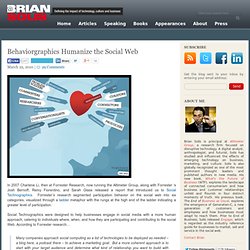

Behaviorgraphics Humanize the Social Web. InShare57 In 2007 Charlene Li, then at Forrester Research, now running the Altimeter Group, along with Forrester ‘s Josh Bernoff, Remy Fiorentino, and Sarah Glass released a report that introduced us to Social Technographics.

Forrester’s research segmented participation behavior on the social web into six categories, visualized through a ladder metaphor with the rungs at the high end of the ladder indicating a greater level of participation. Social Technographics were designed to help businesses engage in social media with a more human approach, catering to individuals where, when, and how they are participating and contributing to the social Web. According to Forrester research… Many companies approach social computing as a list of technologies to be deployed as needed – a blog here, a podcast there – to achieve a marketing goal.
The hierarchy was presented as follows: Creators, those who publish web pages, blogs and other social objects – 13% Inactives – 52% Creators 2007 – 13% 2010 – 24% Communication. Groundswell: How People With Social Technologies Are Changing Ev. Digital Disruption is on everyone's mind.

Netflix is replacing people's cable subscriptions. Simple apps like OpenTable and LoseIt! Are displacing businesses like Zagat's and Weight Watchers. But if you want to understand why, you need to look back at the 80's and 90's and imagine you are an American manufacturer. American manufacturers were successful at making quality products at a good profit, and paying good wages to their workers. The Chinese manufacturers had two things going for them. First, they had cheap labor. Chinese manufacturers also needed access to distribution. So their formula was: cheap workers + infrastructure = disruption. Let's fast foward to today. How Participatory Culture and Mass Collaboration are Shaping our. [Jimmy Wales] “In a certain sense, when things become ubiquitous, they also become "invisible". It used to be that the process of "getting online" for me was a separate step, with a noisy and slow process of a modem on a phone line. Now, with WiFi, my laptop often seems to just simply _be_ on the Internet.
The process of connection has become much less visible, so that the feeling of "my computer" "connecting" to "the Internet" has changed to a feeling that my computer is the Internet, or is "on" the Internet. Similarly, as the Internet becomes ubiquitous on various kinds of devices, it just starts to be part of the assumed fabric of technology. This changes how we relate to it, and how we use it. Q: We are rapidly moving towards an environment where the public is acting not just as consumers, but as producers and contributors. [Jimmy Wales] “Probably one of the most important things is the way participatory culture empowers work in "the long tail". [Jimmy Wales] “There are weaknesses.